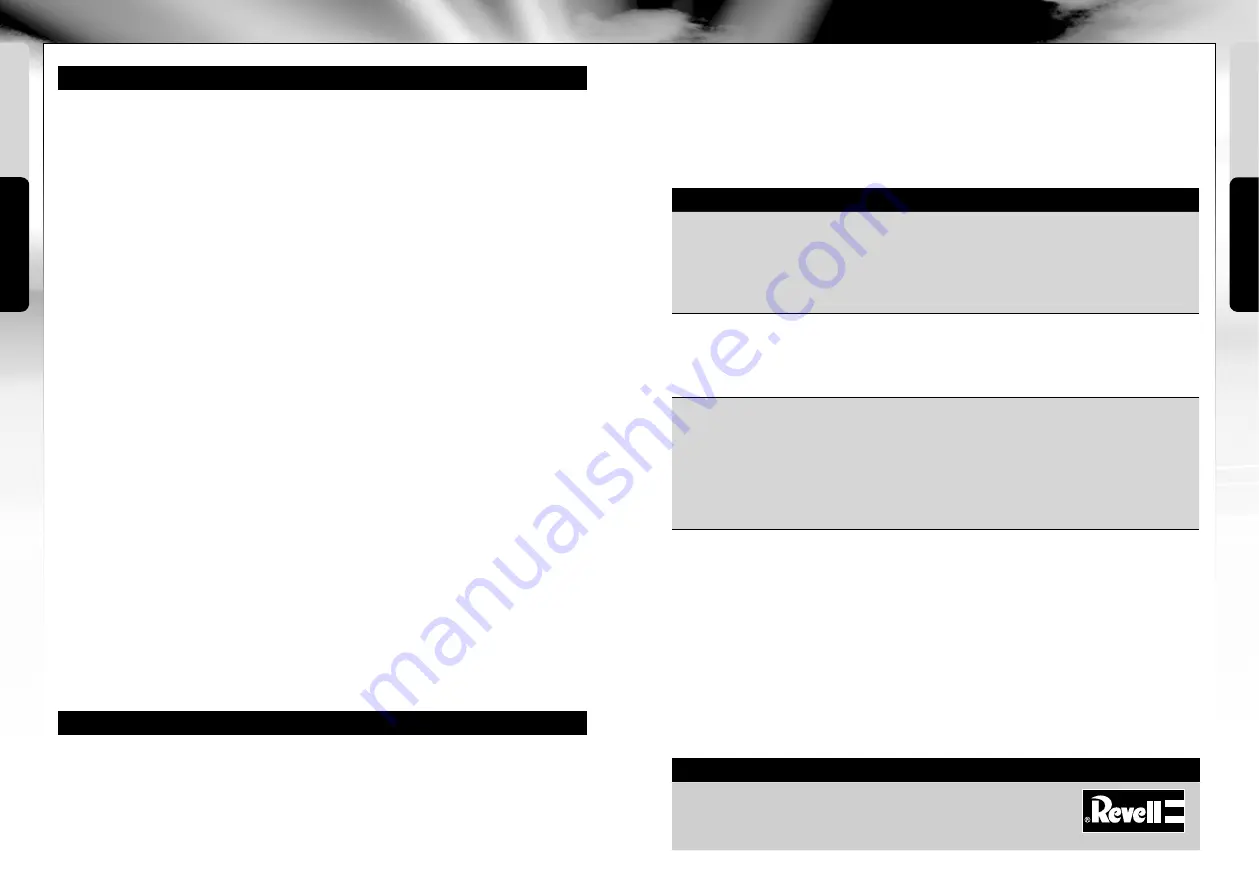
English
English
16
17
www.revell-control.de
serVICe nOTes
Go to www.revell-control.de for ordering information
and tips on replacing spare parts, plus other useful
information on all Revell Control models.
InsTruCTIOns FOr saFe FlYIng
GENERAL FLyING TIPS:
• Always place the helicopter on a level
surface. An inclined surface can, under
certain circumstances, negatively effect
the helicopter during take-off.
• Always operate the controls slowly and
with a gentle touch.
• Always maintain visual contact with the
helicopter and do not look at the remote
control!
• Move the thrust controller somewhat
down again once the helicopter has
lifted off from the ground. Maintain
flying altitude by adjusting the thrust
controller.
• If the helicopter descends, move the
thrust controller slightly upward again.
• If the helicopter climbs, move the thrust
controller down slightly.
• To fly along a curve, tapping the
directional controller very slightly in the
respective direction often suffices. There
is a general tendency during preliminary
attempts at flight to operate the
helicopter's controls too aggressively.
Always operate the controls slowly and
carefully. Never fast and fitfully.
• Beginners should first master trimming
before attempting to master the thrust
controller. It is not necessary for the
helicopter to fly straight at first. It is far
more important to maintain a constant
height of approximately one metre
above the ground by repeatedly tapping
the thrust controller. Only then should
the pilot practise steering the helicopter
left and right.
SUITABLE FLyING ENVIRONMENT:
The location in which the helicopter is flown should fulfil the following criteria:
• It should be an indoor location without any wind. Insofar as possible, there should be
no air conditioning systems, heaters, etc. that can cause air currents.
• The room should be at least 10 metres long, six metres wide and three metres high.
• No disruptive objects, such as fans, lamps, etc. should be present in the room.
• When initialising take-off, make absolutely sure that all persons and animals – including
the pilot – are at least 1-2 metres removed from the aircraft before flight begins.
WARNING!
Flying model aircraft and helicopters outdoors has required mandatory liability
insurance since 2005. Contact your private liability insurer and make sure that your
new and earlier models are included in your insurance coverage. Request written
confirmation and keep this in a safe place. Alternatively, the DMFV offers a trial
membership free of charge online at www.dmfv.aero, which includes insurance.
8 ChangIng The rOTOr BlaDes
If the helicopter's rotor blades have been damaged, they must be replaced.
Proceed as follows:
Prior to installation, make sure that you do not mix up the rotor blades.
The rotor blades are marked with "D1" and "C1"
(8A)
. Type "D1" rotor blades are
mounted on top and Type "C1" rotor blades are mounted on the bottom.
TrOuBleshOOTIng
Problem: The rotor blades do not move.
Cause:
• The ON/OFF switch is in the "OFF" position.
• The battery is too weak or depleted.
Remedy:
• Set the ON/OFF switch to the "ON" position.
• Charge the battery.
Problem: The helicopter stops and descends during flight for no apparent
reason.
Cause:
• The battery is too weak.
Remedy:
• Charge the battery.
Problem: It isn't possible to control the helicopter using the remote control.
Cause:
• The ON/OFF switch is in the "OFF" position.
• The batteries were not inserted correctly.
• The batteries do not have enough power.
Remedy:
• Set the ON/OFF switch to the "ON" position.
• Check whether the batteries are inserted correctly.
• Insert new batteries
Problem: The helicopter only rotates around its axis clockwise or
anti-clockwise.
Cause:
• Excessive trim adjustment to the left or right.
Remedy:
• Reset the left/right trim wheel in the opposite direction
(see point 6: Adjusting the Trim Controller).
Additional tips and tricks can be found online at
www.revell-control.de.
8B
Use a Phillips screwdriver to carefully remove the screws on the rotor blade.
8C
Now carefully remove the rotor blade from the mount.
8D
Carefully fit the new rotor blade in the mount and tighten the screw.
Attention: Do not over-tighten the screw. The rotor blade must have a certain
amount of play.

































